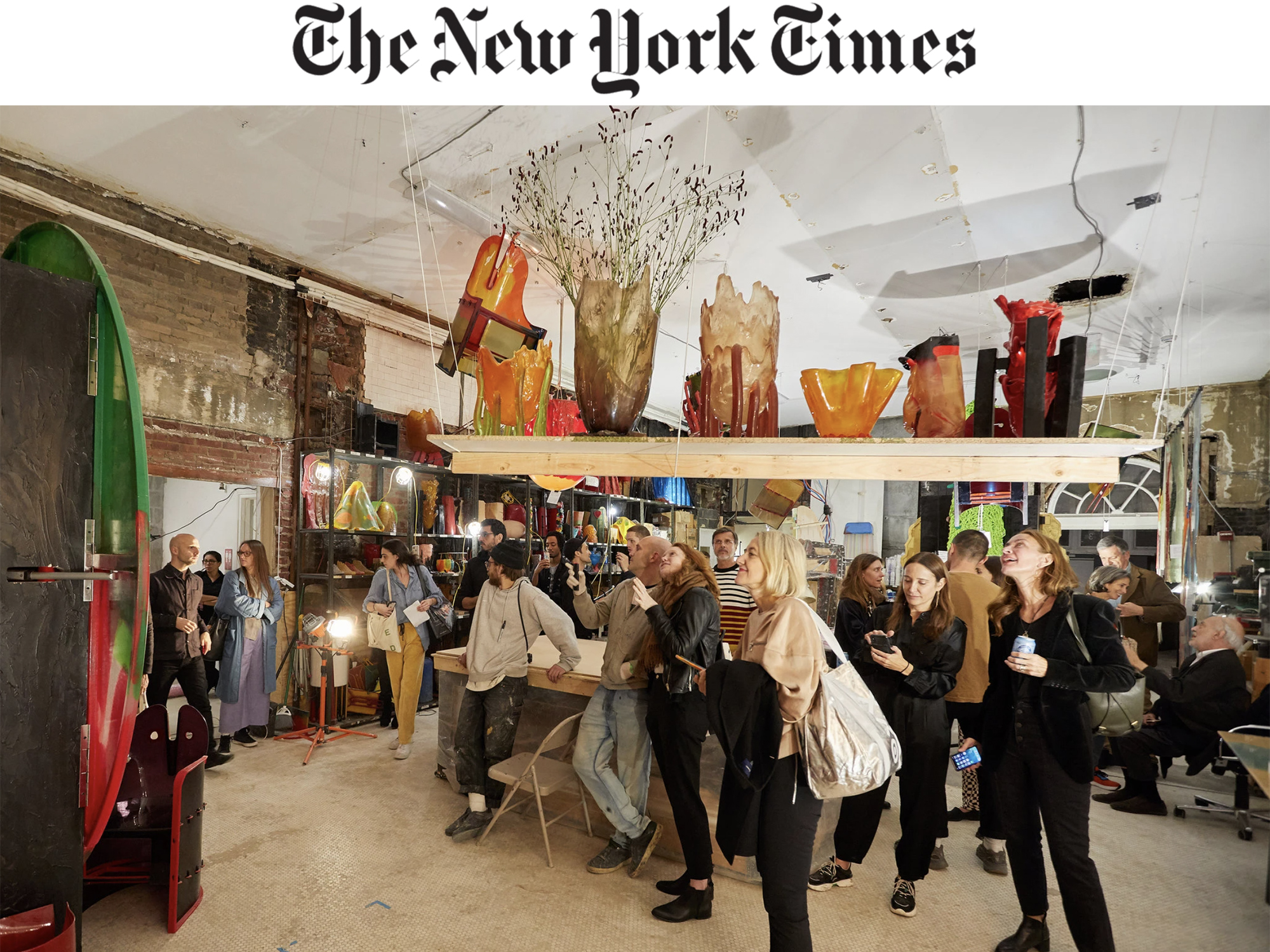By Joseph Giovannini
From immersive art in pop-up storefronts to operas at the Met, performances in New York come in many forms. Recently, Gaetano Pesce — the 79-year-old, Italian-born, perennial enfant terrible of iconoclastic design — performed a chair.
With kids and dogs in tow, visitors drifted into the big, shaggy, ground-floor space of a wing of the former National Academy Museum at 3 East 89th Street, where they found a Geppetto directing assistants in his workshop. The young craftsmen, wearing hoodies and working around Mr. Pesce at three wide tables in the center of the raw, lofty space, poured resins into molds that shaped strange, colorful, rubbery household objects.
The performance, “Working Gallery,” was the first exhibition that Jeanne Greenberg Rohatyn, head of Salon 94 and Salon 94 Design, staged in her gallery’s new space before its renovation. (The final session was cross-listed with Performa for the beginning of its November Biennial.)
If the setting looked authentic, that’s because seven trucks loaded with the contents of Mr. Pesce’s Brooklyn studio had transported his working archive here, along with the table saws, lathes and tool sets that he uses to create his bestiary of imaginary creatures. Many objects in this haunted shop, whether a vase, chair, lamp or wall hanging, had lips, eyes or a face, and intimations of a soul. Vases sprouted centipede legs and wafting tendrils.
Some pieces stood on pigeon-toed feet, and others grew flippers, fins, fingers and toes. All were squishy to the touch, looking as if they would bounce if dropped. Visitors had basically walked into a home furniture store for a Hobbit world in Middle-earth — though nothing was for sale.
The main event of each session was the daily chair. With a barrel-shaped, oxblood red specimen hanging overhead, the seated Mr. Pesce, chatting amiably all the while, dripped white and black pigment off a stick into a pot of murky English-green that the assistants mixed with spatulas before streaming into narrow troughs lining two molds. Then they poured a layer of a deep-Burgundy resin over the whole flat surface of the mold, turning it into a glassy, gelatinous pond. Earlier layers became suspended in the mix, as though spreading in amber. Letting the brew congeal for a day, the workers pried the stiffened resin off the mold, and fit the two parts together into another iteration of the chair hanging over Mr. Pesce.
No two chairs, and none of his utilitarian creatures hanging out in the room, are alike. Mr. Pesce does not run a factory stamping out product. Each pour involves variations initiated by assistants working as artists.
Mr. Pesce has roots in the 1960s as a performance artist, when, in the spirit of the anti-establishment times, he once filled an entire auditorium with fake blood. Unlike most performances, which vanish, the objects he “performs” lock traces of the action in the translucent resins. Bubbles are captured. Drawings fuzz into the matrix. Every object is a unique time-lapse record of its becoming, a visual gerund.
In Italy, where he came of age studying architecture at the University of Venice, Mr. Pesce rebelled against the idealized, simplified furniture and industrial objects of Milan’s Bel Disegno. He didn’t want to design the perfect spoon.
He soon abandoned the exalted objects of High Modernism. In Chelsea, in a complementary show, specimens from his early experiments from the ’60s through the ’90s, are exhibited in “Gaetano Pesce: Age of Contaminations,” a show at Friedman Benda (through Dec. 14). Unlike the objects in “Working Gallery,” expressions of a fully developed aesthetic, this collection of 20 or so rarely assembled furnishings, some commissioned for private homes, show the trials he matured through to arrive at his performance on Fifth Avenue.
With a few defining strokes, he paints whimsical faces on tables, chairs and doors, breaking with Modernism’s abstraction, blurring the boundary between art and design. He violates his own Italian DNA by escaping the pursuit of beauty: with sculpting knives, he crudely paints the surfaces of cabinets, closets and bookcases with murky, impure colors. And he abandons the traditional use of wood and the Modernist use of plastics and fiberglass in favor of polyurethanes and resins that open up the notion of process as part of the artistic message.
Most important, instead of the repetitive action of the machine, Pesce pursues the autonomous gesture of the individual. Workmen making side chairs sat in the forms they were making, impressing the chairs with their own forms.
Then there is the element of sheer invention. His Blue Seaweed Cube Reading Chair, which might also have been named after fettuccine, is alive with glee.
This ’60s rebel went on to be the respected dean of the avant-garde, his career framed by inclusion in shows at MoMA, the Pompidou Center and Rome’s MAXXI. Against the grain of his ’60s self, he now belongs to the pantheon he challenged and changed.










